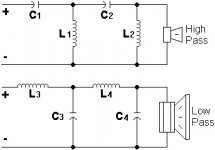lol... so its really funny. started this post and it shows the similar threads and all the threads written about the 5208c have been started by me. Just goes to show that maybe i should FINALLY start something with these drivers.
So couple of questions:
1) Using the T/S parameters I get about a -3 of 70hz in a 23L enclosure. With room gain is this really low enough for a set of bookshelf speakers?
2) Is there a company out there that does custom xovers and measurements of drivers?
3) If i wanted to add a helper woofer onto the 5208c would it be better to run the 5208c in a sealed ... say a 11L enclosure and run the 2nd woofer in a ported. Should this extra woofer be better on front next to the 5208c or on the back? I was looking at the Ciare FXC8-3. Just have to blend the responses and sensitivity of the drivers.
What is everyone's thoughts??
help!!! thanks in advance!!
So couple of questions:
1) Using the T/S parameters I get about a -3 of 70hz in a 23L enclosure. With room gain is this really low enough for a set of bookshelf speakers?
2) Is there a company out there that does custom xovers and measurements of drivers?
3) If i wanted to add a helper woofer onto the 5208c would it be better to run the 5208c in a sealed ... say a 11L enclosure and run the 2nd woofer in a ported. Should this extra woofer be better on front next to the 5208c or on the back? I was looking at the Ciare FXC8-3. Just have to blend the responses and sensitivity of the drivers.
What is everyone's thoughts??
help!!! thanks in advance!!
I designed a passive xo for the 5208, only have it in a test box atm and the top end measures a bit rough but it seems to work pretty well with a sub. I'm using them for surrounds btw, not sure what your plan for them is. My test enclosure is ~15L .
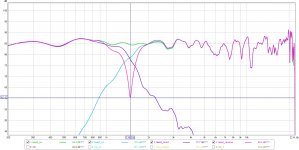
I can post my xo if you like.
Which T/S params did you use btw? I ended up measuring mine mine but there seem to be quite a few variations out there. I got data from radian before I got mine which I can also post if that would be helpful.

I can post my xo if you like.
Which T/S params did you use btw? I ended up measuring mine mine but there seem to be quite a few variations out there. I got data from radian before I got mine which I can also post if that would be helpful.
Last edited:
here you gosure if you have the schematic i would love it. what are your impressions of the Radian?
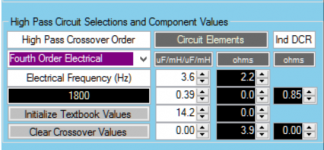
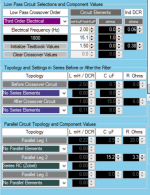
let me know if you need any other data, I have polars and obviously the raw frd/zma
I find it's a perfectly competent performer when underpinned by a sub, I designed for 20 degrees off axis and that + a gentle rolloff towards the HF helps tone down the roughness seen in the FR
Yes they do, at double the price though.Interesting, they offer a berrylium upgrade for the compression driver I believe, at one point I was very tempted to try that.
Yes they do, at double the price though.
Which is why I thought it would be much better if you tried them first.
Actually, it didn't seem to bad when compared to the normal price for beryllium tweeters from others, and still expensive.
Best,
Erik
one thing to point out about this design... the z offset between the 2 drivers mean that designing for on axis was quite hard (i.e. beyond my passive xo skills) as they're a way apart acoustically. Moving the design axis to 15-20 degrees off axis made it much easier (and actually fits my layout anyway given that I'm using them for surrounds)
I ended up measuring mine mine but there seem to be quite a few variations out there. I got data from radian before I got mine which I can also post if that would be helpful.
Please do as there's no such thing as too much driver technical data available.
TIA,
GM
OK some data coming upPlease do as there's no such thing as too much driver technical data available.
TIA,
GM
Gene@Radian sent me these ts params
Code:
5208 BC
* Loudspeaker Measurement System
* LMS(TM) 4.2.0.260 Nov/29/2000
* (C)opyright 1993-2000 by LinearX Systems Inc
* ElectroMech Speaker Parameters *
* Oct 12, 2011 Wed 3:05 am
* Library=New 5208 BCZIMP.lib
* Reference Curve=5208 BC N4
* Delta M/C Curve=current
* Method= Single Curve - with Mmd
* Domain= FreeAir
* Model= LEAP
Revc= 5.200 Ohm
Fo= 89.230 Hz
Sd= 19.800m sqM
Krm= 1.271m Ohm
Erm= 0.852
Kxm= 21.235m Ohm
Exm= 0.623
Vas= 7.568m cuM
Cms= 135.946u M/N
Mmd= 21.800 g
Mms= 23.402 g
BL= 11.171 TM
Qms= 5.583
Qes= 0.547
Qts= 0.498
No= 0.951 %
SPLo= 38.906K R
Xmax = +/- 4.45mm (.175in)
* EndI use DATS and my data was in the same ballpark as this so I suppose this is a good spec
They also gave me this FR which is a bit less smoothed than their usual published stuff but still a pretty wide scale
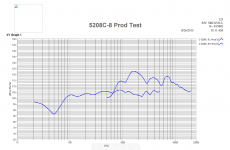
my data next, driver in test box (300mm x 300mm baffle) and measured outside
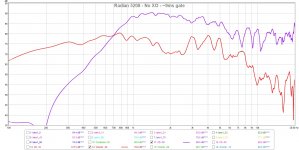
nearfield of the woofer
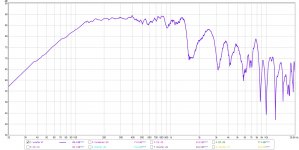
My raw data for z offset
View attachment 5208c_raw_data_cd.zip
View attachment 5208c_raw_data_combined.zip
View attachment 5208c_raw_data_woofer.zip
My processed data I used for the schematic posted earlier, includes zma and minimum phase frd
View attachment 5208c_xo_design.zip
calculated z offset was 9.6cm
couple of polars with a not quite final version of the xo (changes after this were to pull the hf down a bit and adjust the cross a touch)
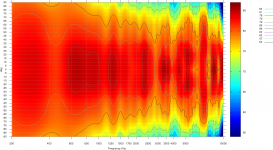
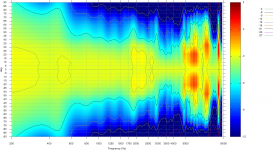
the black line is the -6dB line, normalised is to 0 degrees. I can normalise to other reference spl or angles (ugly but functional script is published to https://github.com/3ll3d00d/directivity-utils ) if anyone wants it.

nearfield of the woofer

My raw data for z offset
View attachment 5208c_raw_data_cd.zip
View attachment 5208c_raw_data_combined.zip
View attachment 5208c_raw_data_woofer.zip
My processed data I used for the schematic posted earlier, includes zma and minimum phase frd
View attachment 5208c_xo_design.zip
calculated z offset was 9.6cm
couple of polars with a not quite final version of the xo (changes after this were to pull the hf down a bit and adjust the cross a touch)


the black line is the -6dB line, normalised is to 0 degrees. I can normalise to other reference spl or angles (ugly but functional script is published to https://github.com/3ll3d00d/directivity-utils ) if anyone wants it.
Last edited by a moderator:
Ideal would be to get the crossover from the Galante Audio Rhapsody
that uses the 802, a steal basked version of the 5208.
Here is what it says in the enjoythemusic review:
Someone at Galante Audio was doing their homework as the crossover gave an incredibly smooth mating of the two drivers. In fact i settled on a tweeter adjustment of neutral as best. While some multi-driver speakers have audible frequency reduction or augmentation in the crossover range, there seemed to be a excellent matching in the crossover region. Being of coaxial design, there was no horizontal discontinuity from driver to driver.
Klaus
that uses the 802, a steal basked version of the 5208.
Here is what it says in the enjoythemusic review:
Someone at Galante Audio was doing their homework as the crossover gave an incredibly smooth mating of the two drivers. In fact i settled on a tweeter adjustment of neutral as best. While some multi-driver speakers have audible frequency reduction or augmentation in the crossover range, there seemed to be a excellent matching in the crossover region. Being of coaxial design, there was no horizontal discontinuity from driver to driver.
Klaus
Ideal would be to get the crossover from the Galante Audio Rhapsody
that uses the 802, a steal basked version of the 5208.
Here is what it says in the enjoythemusic review:
Someone at Galante Audio was doing their homework as the crossover gave an incredibly smooth mating of the two drivers. In fact i settled on a tweeter adjustment of neutral as best. While some multi-driver speakers have audible frequency reduction or augmentation in the crossover range, there seemed to be a excellent matching in the crossover region. Being of coaxial design, there was no horizontal discontinuity from driver to driver.
Klaus
Klaus,
I was under the impression that Galante Audio used the stock Radian cross-over in their speakers. The specs were certainly identical to the Radian crossover, IIRC.
In my Open Baffle pair of Radian 520's I'm using a cross-over designed by the Pacific Northwest's DIY Crossover King: Dave Rosgaard. It certainly sounds extremely nice.
Best Regards,
TerryO
3ll3d00d ,
Thanks for all the info on your crossover design.
I'm not familiar with the crossover nomenclature that you provided for the schematic. Could you be kind enough to provide correlation of values to position in diagram, such as below?
See:
Speaker Crossover Calculators by V-Cap
and scroll down. Alternatively, use XSim's crossover blocks, same idea.
If you were serious about this, I'd:
1. get the drivers
2. put them in your target cabinet (or baffle, whatever)
3. Measure frequency response and driver impedance separately without crossovers (OmniMic + DATS) .
3.5 Measure speakers together to calculate acoustic offsets.
4. Import to XSim
5. Design crossover.
Others recommend other tools, but this is what I like.
This won't make you a crossover designer, per se, but if you want to invest into an ideal crossover, this is what I would recommend.
If you want to compare at say, 30degrees, do the same process only create separate frequency charts AND acoustic offsets at 30 degrees. Then you can use XSim for both straight on and on-angle simulations by changing the driver files. You will only need to get the driver impedances in-cabinet once though, those are constant regardless of listener location.
Now you have a powerful tool to design 2nd and 4th order crossovers and compare them straight on and at an angle. This will tell you if it's worth doing a 4th order or not, as well as letting you play with the on-angle phase response. Maybe phase matching for the middle of your intended listening area will work better than straight on. The best part is, once you've measured your speaker drivers you can iterate through several different designs quickly. So long as you are organized about saving the results from each trial in the right place, you'll do in weeks what designers had to do in a year.
Best,
Erik
Last edited:
- Home
- Loudspeakers
- Multi-Way
- Radian 5208c coaxial project
